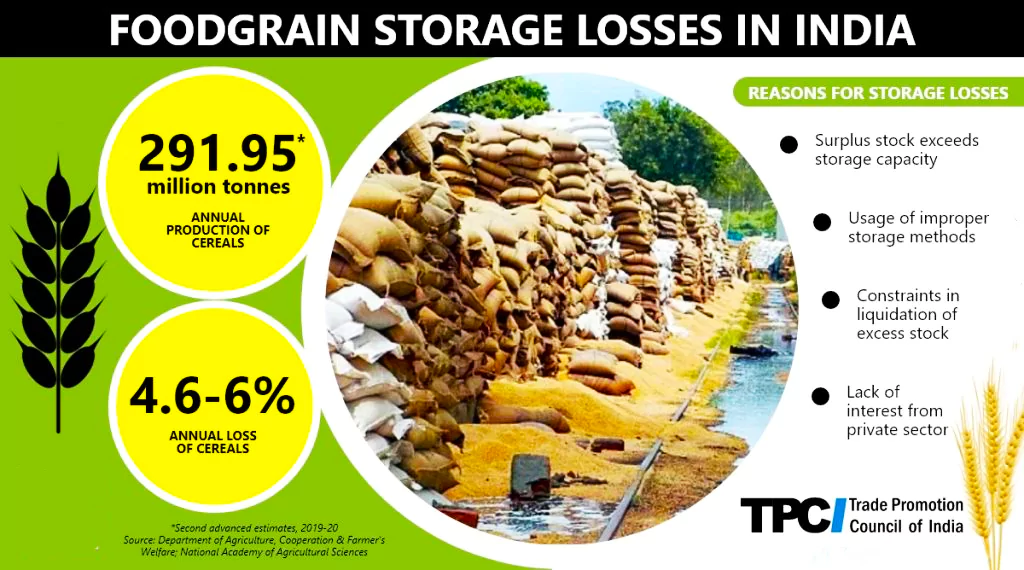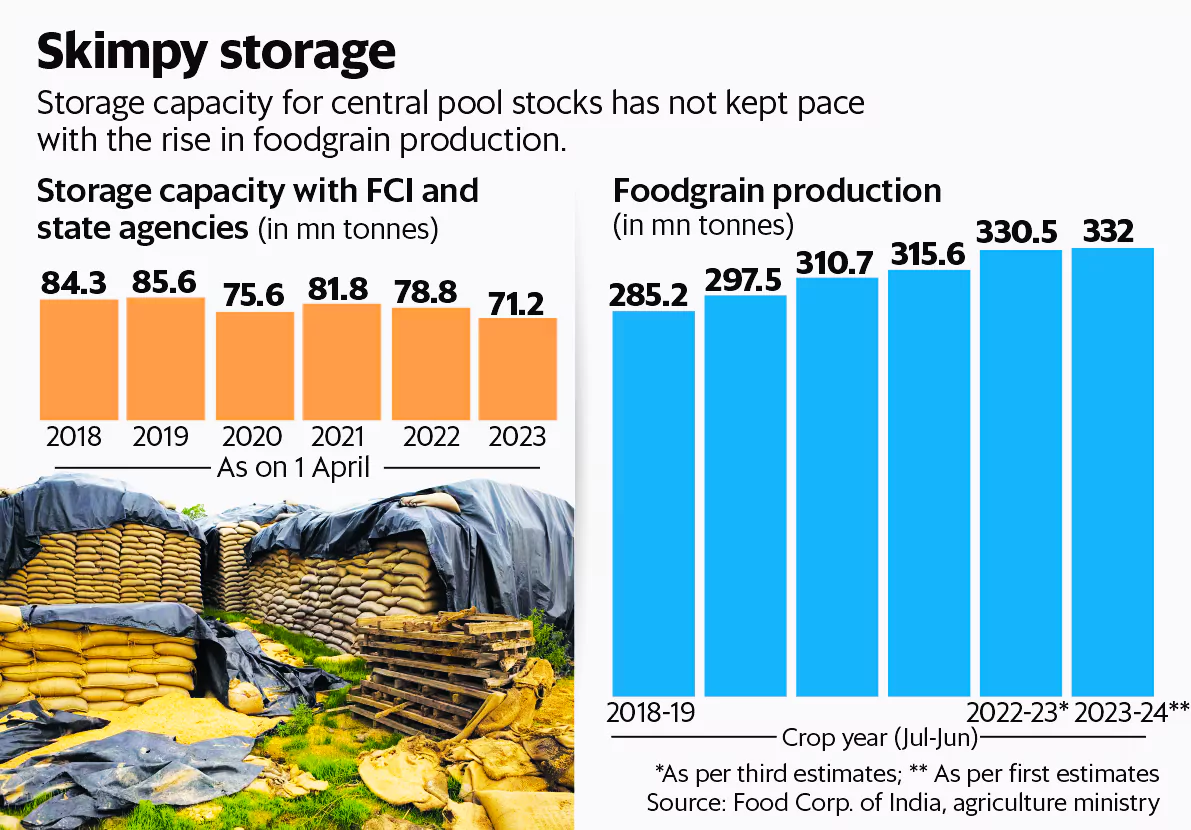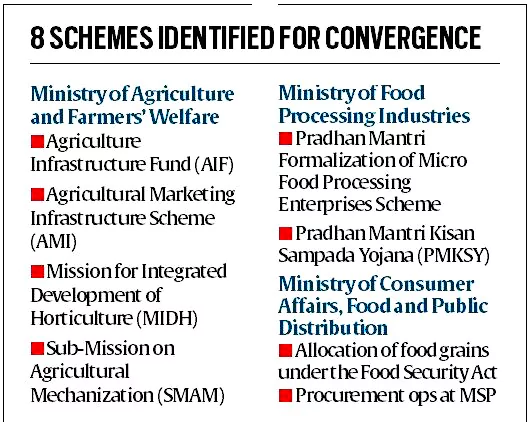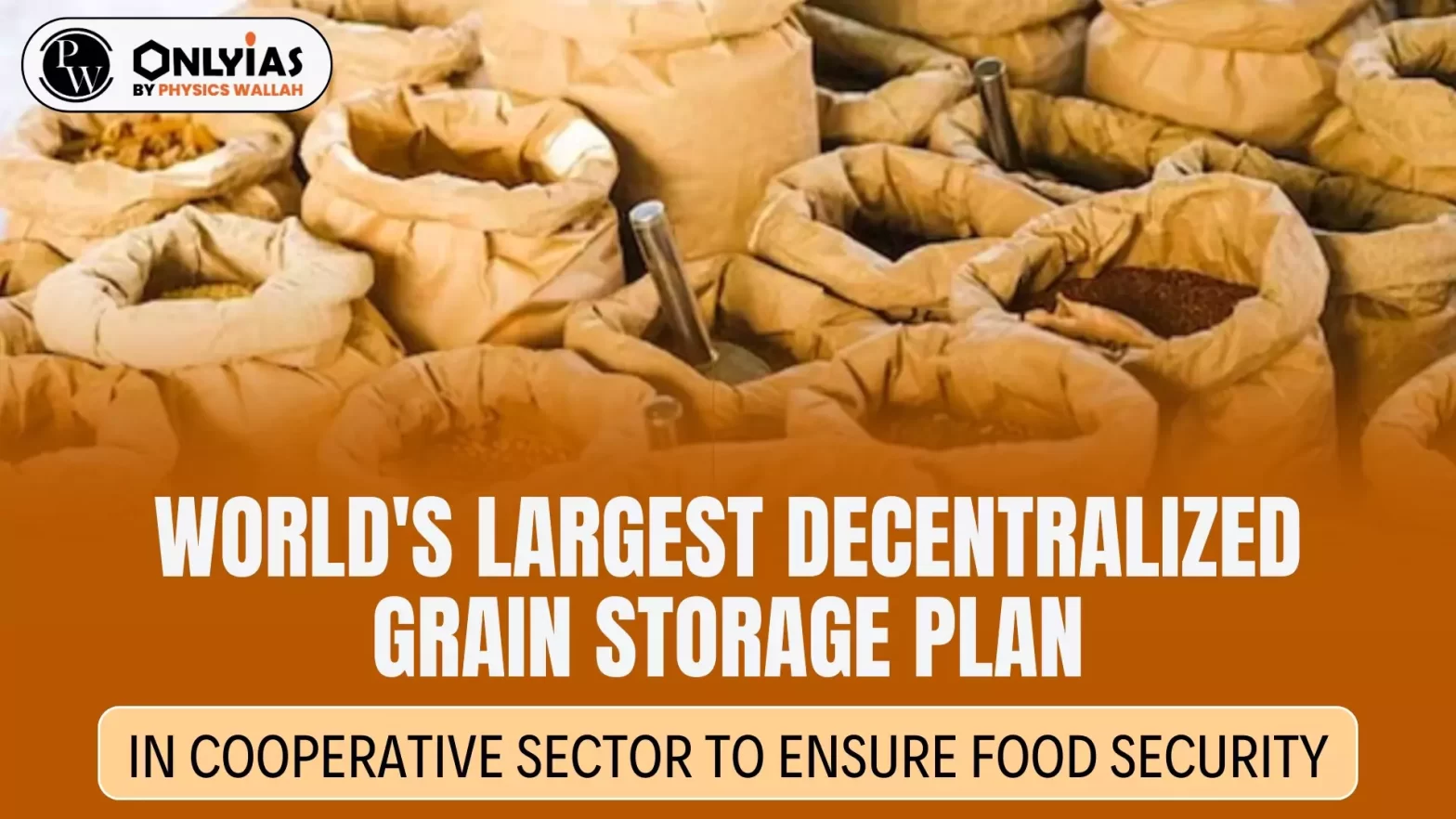Context:
This article is based on the news “Express View on government’s new grain storage plan: More in store” which was published in the Indian Express. Recently, the Indian Prime Minister launched the “World’s Largest Grain Storage Plan in the Cooperative Sector”.
World’s Largest Grain Storage Plan Carried Out in 11 States

- Approval: To address the shortage of foodgrain storage capacity in the country, the government has approved this plan in May 2023.
- The project is being carried out in 11 states by primary agricultural credit societies (Uttar Pradesh, Madhya Pradesh, Tamil Nadu, Tripura, Uttarakhand, Rajasthan, Maharashtra, Assam, Gujarat, Karnataka and Telangana).
- Vision: Thousands of Primary Agricultural Credit Societies (PACS) from across the country will join it in the next couple of years to reach 100% storage capacity before 2027.
Need for Grain Storage
- Ensuring Food Security: India holds 11% of the World’s total Cultivable Area and 18% of the Total World Population. India runs the world’s largest food programme under the National Food Security Act, of 2013, which covers about 81 crore people. Therefore, to ensure the food security of a billion-plus population, a robust network of foodgrain storage facilities becomes essential.
 Shortage of Storage: Based on the FAO Statistical Data 2021, total Food Grain Production in India is 311 MMT and total Storage Capacity in India is only 145 MMT, i.e., a shortage of 166 MMT of Storage.
Shortage of Storage: Based on the FAO Statistical Data 2021, total Food Grain Production in India is 311 MMT and total Storage Capacity in India is only 145 MMT, i.e., a shortage of 166 MMT of Storage. -
- There is surplus Storage capacity in other countries at 131%, while in India there is a shortfall of 47%.
- Embodying the Vision of “Sahakar-se-Samriddhi”: Recognizing the significance of cooperatives as a potent force for economic growth, the government represents the vision of “Sahakar-se-Samriddhi” (Prosperity through Cooperation).
- To drive this vision, the Ministry of Cooperation has introduced an unprecedented initiative—the ‘World’s Largest Grain Storage Plan in the Cooperative Sector.
- National Food Security Act (NFSA): It aims to provide food security to eligible beneficiaries by ensuring access to adequate food grains at subsidised prices, which requires good storage facilities to counter deterioration challenges and enhance the longevity of seeds and crops.
- Regional Disparities: In India, the storage capacity varies across various regions.
- Example: Some southern states have a storage capacity of 90% and above, while northern states have capacities below 50%.
About the World’s Largest Grain Storage Plan
It is India’s ambitious plan in the cooperative sector that is poised to revolutionise agriculture and the Fast-moving consumer goods (FMCG) industry.

- To Enable PACS Participation: The Plan entails the creation of various agri infrastructures at the PACS level, including setting up decentralised godowns, custom hiring centres, Fair Price Shops, etc. The Budgetary Allocation: Though the plan does not have a separate allocation, it will be implemented by converging 8 schemes. (Refer to image).
- Financial Support by NABARD: Refinancing PACS at highly subsidised rates of around 1% after incorporating the benefits of 3% interest subvention under the Alternative Investment Fund (AIF) scheme for projects up to Rs. 2 Crore.
- Implemented by: The National Cooperative Development Corporation (NCDC) with the support of NABARD, Food Corporation of India (FCI), Central Warehousing Corporation (CWC), NABARD Consultancy Services (NABCONS), National Buildings Construction Corporation (NBCC), etc. in different States/ UTs.
- An Inter-Ministerial Committee (IMC): It has been constituted to ensure accountability and smooth, effective and transparent implementation of the plan.
- A National Level Coordination Committee (NLCC): It has also been constituted having members from Ministry/Departments, Central Government agencies concerned to steer the overall implementation of the Plan and reviewing the progress of implementation, etc.
- Monitoring: State Cooperative Development Committee (SCDC) at State level and District Cooperative Development Committee (DCDC) in each District of the State/UT have also been constituted.
- Aim:
-
- To set up a storage infrastructure of 700 lakh metric tons.
- To double the Existing Storage Statistics
- To set up a network of integrated grain storage facilities through PACS nationwide.
- Strengthen the Economic Condition of PACS
Benefits of Increase in the Grain Storage Infrastructure
- Reduction in Post-harvesting Losses: By creating sufficient storage capacity in the country and strengthening food security of the country up to Panchayat/village level.
- Bring down the Food Grain Handling and Transportation Cost: Since PACS would be operating as a procurement center as well as Fair Price Shops (FPS), the cost incurred in transportation of food grains to procurement centers and again transporting the stocks back from warehouses to FPS would also be saved.
- Ensuring Food Security: This Plan would help in ensuring food security at Panchayat/ village level across the country, thereby benefiting the consumers.
- An Efficient Food Supply Chain: By leveraging the extensive network of PACS, the plan aims to bridge the gap between farm produce and consumer demand, ensuring a stable and efficient food supply chain.
- Various Benefits to Farmers:
-
- Farmers would have a choice to sell their produce depending on the market conditions, and not be forced into distress sale.
- They will be able to get various agri inputs and services at the Panchayat/ village level.
- By diversifying their businesses, farmers will be able to get additional sources of income.
- Through integration with the food supply management chain, farmers can expand their market size and realise better value for their produce.
- Reduction of post-harvest loss will lead to enabling farmers to earn better prices.
Challenges that Need to be Tackled
- Non-functional PACS: A large number of PACS are currently dysfunctional.
- Example: Only about 63,000 out of 1 lakh PACS are currently operational in India.
- Bureaucratic Challenges: The convergence and coordination of various schemes might present intricate bureaucratic challenges.
- Multiplicity of institutions with cross-cutting objectives are likely to dilute their effectiveness.
- Lack of Infrastructure & Technology: Setting up modern storage facilities and implementing digital solutions might pose a challenge given the rural setting and the potential lack of technological infrastructure.
- On Skill Development: The plan could generate local employment opportunities, however it would require skilled people to operate and manage the advanced storage facilities, which poses a challenge of skill development.
- Governance Issues: Placing food storage under the purview of agricultural cooperative societies appears to be puzzling in the context of another high-profile government initiative FPOs.
- FPOs are also involved in post-harvest handling of the produce that may come in conflict with the agriculture co-operatives.
- Inefficient Functioning of Agriculture Cooperatives: The inefficient functioning of agriculture co-operatives is widely acknowledged, still handing over the implementation of the storage infrastructure along with financial responsibilities lie on it.
- However, FPOs are being run as businesses with better governance structure.
- Maintenance of Infrastructure: It is easy to create infrastructure but managing and maintaining it is a bigger challenge. India has an unenviable record of maintaining its infrastructure, be it FCI storage, drinking water systems, irrigation systems, etc.
- Capital maintenance expenditure (Capex) is rarely incorporated into annual budgets. More importantly, none of these systems are financially viable due to various reasons.
- Other Problems: It includes elite capture, bureaucratic/political interference and poor marketing. The measures being taken to resolve them need to be spelled out.
Actions taken by the Government to Support Cooperatives
- The new storage plan points towards the increasing emphasis the government is placing on cooperatives.
- The Government had previously outlined a plan to establish two lakh primary agricultural credit societies (PACS), dairy and fisheries cooperatives in the country.
- The Union Budget 2023-24 flagged the initiation of the process of computerisation of 63,000 PACS with an investment of Rs 2,516 crore.
- The formation of a Ministry of Cooperation in 2021, is also indicative of this Cooperatives priority.
Why is the PACS Network Chosen for the New Plan?
- A Huge Base & Spread: More than 1,00,000 PACS are spread across the country with a huge member base of more than 13 crore farmers.
- Inclusiveness: The disaggregated data shows that small and marginal farmers and others accounted for 81% of these more than 13 crore members and around 60% of lending of district central cooperative banks is through these societies.
- Critical Role in Problem-Solving: PACS has a critical role in solving farmers problems “through group/collective strength”. Successful Examples: Amul and Lijjat Papad.
- A Vital Link: The appeal of PACS rests in these societies serving as the last, but vital, link in the cooperative credit structure.
About Primary Agricultural Credit Societies (PACS)
- PACS are village-level cooperative credit societies.
- The first PACS was established in 1904.
- They serve as the last link in a three-tier cooperative credit structure headed by the State Cooperative Banks (SCB) at the state level.
- They offer last-mile connectivity to farmers in disbursing credit.
- Short Term Lending: PACS can extend credit i.e., Crop loans with minimal paperwork within a short time.
Initiatives to Address Food Grain Shortage:
- Agriculture Infrastructure Fund (AIF): It envisages the creation of post-harvest management infrastructure and community farming assets through incentives and financial support.
- Pradhan Mantri Annadata Aay SanraksHan Abhiyan (PM-AASHA): For providing Minimum Support Price (MSP) to farmers for produce of notified oilseeds, pulses and copra.
- Price Support Scheme (PSS): It exempts procured pulses, oilseeds and copra from mandi tax.
- Central nodal agencies undertake procurement directly from pre-registered farmers at MSP when prices fall below MSP.
- Price Deficiency Payment Scheme (PDPS): It involves direct payment of the difference between MSP and the selling price.
- Private Procurement and Stockist Scheme (PPSS): Procurement is conducted on a pilot basis from pre-registered farmers in selected districts or APMCs.
- Market Intervention Scheme (MIS): It entails procurement of agricultural and horticultural commodities that are perishable and for which MSP is not announced.
- Bhartiya Beej Sahakari Samiti Limited (BBSSL): Under the Multi-State Cooperative Societies Act, 2002, BBSSL has been set up as an Umbrella organization for the cultivation, production and distribution of improved seeds and to boost the productivity of crops and enhance the farmers’ income.
About National Food Security Act (NFSA)
- It is a social welfare legislation introduced in 2013, with an aim to provide food security to eligible beneficiaries by ensuring access to adequate food grains at subsidized prices.
- Scope of Beneficiaries: The NFSA aims to cover up to 75% of the rural population and up to 50% of the urban population, totaling around 81.35 crore persons.
- Additional Beneficiaries: There is scope to identify 1.24 crore more beneficiaries across 21 states and UTs.
- Entitlement: Eligible households receive 5 kilograms of foodgrains per person per month at subsidized prices specified in the schedule.
- Free Foodgrains: Under NFSA, eligible beneficiaries can buy food grains at subsidized rates—rice at Rs 3/kg, wheat at Rs 2/kg, and nutri-cereals at Rs 1/kg.
|
Way Forward
- Quality Infrastructure: Modernizing the existing storage infrastructure should be a priority, especially for perishable commodities (fruits, vegetables, milk, meat, fish, etc.).
- In the case of perishables, processing can increase the longevity of the food and may reduce its nutrition value. Hence, modern technologies are required for ensuring high quality processing.
- Judicious Planning: India has the storage capacity for only one-eighth of its annual perishable produce. This requires judicious planning and estimation of storage requirements for different products across the regions of the country.
- Revival of PACS: These societies need to be revived and made operational to receive the best of potential of the plan.
- Address Climate Change Impact: Efforts need to be made to mitigate the impact of climate change on foodgrain storage by using modern technologies.
- Encouragement to the Private Sector: To work on the poor track record of co-operatives, the Centre tried to encourage the private sector to invest in marketing infrastructure.
- Focus on Private-Public-People (PPP) Initiative: To gain more positivity, there would be a focus on the private-public-people (PPP) initiative along the lines of FPOs.
- Even bringing it under the umbrella of FPO would have been a better option.
- Use of Hermetic Storage: Hermetic storage is an airtight storage technology for agricultural commodities. It uses the concept of a modified atmosphere to protect commodities that are sensitive to moisture.
- It removes the possibility of pest infestation by preventing gas exchange from the surrounding environment. Lack of interaction with the atmosphere also ensures the stored commodities are free from toxic substances like aflatoxin.
Conclusion
As India works towards achieving its global commitments and fostering sustainable agricultural practices, the storage capacity expansion plan is a shining example of India’s dedication to economic growth, food security, and rural development.
Also Read: Farmers Protest 2.0: Are Farmers Demands Unjustified?
| Prelims PYQ (2021):
In the context of India’s preparation for ClimateSmart Agriculture, consider the following statements:
1. The ‘Climate-Smart Village’ approach in India is a part of a project led by the Climate Change, Agriculture and Food Security (CCAFS), an international research programme.
2. The project of CCAFS is carried out under Consultative Group on International Agricultural Research (CGIAR) headquartered in France.
3. The International Crops Research Institute for the Semi-Arid Tropics (ICRISAT) in India is one of the CGIAR’s research centres.
Which of the statements given above are correct?
(a) 1 and 2 only
(b) 2 and 3 only
(c) 1 and 3 only
(d) 1, 2 and 3
Ans: (d) |
![]() 27 Feb 2024
27 Feb 2024


 Shortage of Storage: Based on the FAO Statistical Data 2021, total Food Grain Production in India is 311 MMT and total Storage Capacity in India is only 145 MMT, i.e., a shortage of 166 MMT of Storage.
Shortage of Storage: Based on the FAO Statistical Data 2021, total Food Grain Production in India is 311 MMT and total Storage Capacity in India is only 145 MMT, i.e., a shortage of 166 MMT of Storage. 
